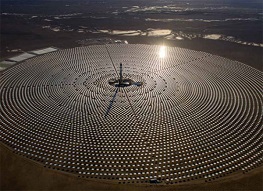Science and technology
Morocco set to become Africa's solar superpower
The first Noor 1 phase of the venture was switched on at the beginning of February 2016. It is expected to begin supplying over a million households in Morocco and its neighbours using sun energy gathered from 500 000 solar mirror panels. The panels gather and concentrate the sun's energy to heat water that produces steam that powers energy-generating turbines. The advantage of solar thermal power, apart from its limitless source, is its heat storage capabilities. It stores the heat to make energy at night. Unlike conventional photovoltaic (semi-conductor cell) systems, thermal systems don't suddenly produce less when a cloud passes over.NOOR 1, the first 160 megawatt power plant! @Ouarzazate https://t.co/ww2Sjqvzoo pic.twitter.com/exdlWvOsvZ
— SOLAR IMPULSE (@solarimpulse) February 16, 2016
The solar panel concept is popular in parts of the world where sunlight is constant throughout the year, particularly in deserts. The largest functioning solar panel project is currently in operation in the Mojave Desert in the USA, according to The Guardian. In 1986, the German particle physicist, Gerhard Knies, calculated that the world's deserts received enough energy in a few hours to provide for humanity's power needs for a whole year. The challenge though, has also been successfully capturing the energy generated and transporting it from the desert plants to urban areas. With growing, adaptable infrastructure, as well in research into the technology, Africa is perfectly suited to lead the way in finding affordable, practical solutions.Cool infographic showing how solar thermal works #CleanTech#Solar #Water #coal #fracking #oilandgas #Oil #Renewable pic.twitter.com/PDFuhHj2gj
— Greenbelt Solar (@greenbeltsolar) October 30, 2013
Solar thermal energy in South Africa
Weather conditions and topography in South Africa offers perfect conditions for the solar panel concept, with various projects already using the technology in South Africa. Operational plants in Pofadder, Upington and Groblershoop generate 200MW of power, while new plant constructions in Northern Cape, including the Redstone and Xina CSP operations, will add another 300MW to the national grid over the next three to five years. The Helio100 project at Stellenbosch University is researching prototype small- scale concentrated solar power for use in the consumer market. Meanwhile, in Morocco, the first phase of the Noor installation covers hundreds of hectares, but once completed in 2020, Noor will span more than 24km2, an area larger than the country's capital city of Rabat. Noor 1 is creating 160 megawatts of power, making it, even in this first phase, one of the world’s largest solar thermal power plants. As Noor 2 and 3 are completed, the energy generation is expected to be 580 megawatts.Almost half of Morocco's energy is expected to come from renewable energy, with a third of that from solar. According to the World Bank, Morocco currently imports 97% of its energy. It believes its investment in the solar plant will help to make the country less reliant on those imports and reduce its long-term carbon emissions by millions of tons. Together with the African Development Bank and the Moroccan government, the World Bank has invested almost $700-million to begin the first phase of the Noor project that will, over the next 10 to 20 years, bring much-needed renewable energy solutions to Africa and the world. Source: AFKInsiderThe Noor Ouarzazate Solar Complex, world’s largest solar power plant was located in which country?Morocco pic.twitter.com/JzZYpuhGcg
— General Knowledge (@GKFORWIN) February 12, 2016
 The Redstone Solar Thermal Power near Postmasburg in the Northern Cape will be completed in 2018. Solar thermal power plant are one of largest growing renewable energy trends and Africa is perfectly suited for the idea. The Noor solar project in Morocco, opened in February 2016, is the largest plant in Africa. (Image: SolarReserve)
The Redstone Solar Thermal Power near Postmasburg in the Northern Cape will be completed in 2018. Solar thermal power plant are one of largest growing renewable energy trends and Africa is perfectly suited for the idea. The Noor solar project in Morocco, opened in February 2016, is the largest plant in Africa. (Image: SolarReserve)
Related links
Related articles
- Solar solution mooted for Africa's produce wastage problem
- South African research team develops concentrated solar power system
- Community will benefit from wind farm
- Hydrogen powers South African schools
- South Africa benefits from renewables
- West Coast One helps to power South Africa
- KaXu Solar One to ease pressure on SA's energy grid
- New solar plants in sunny Northern Cape
- Khi Solar One: renewable energy for the ages




